Description
Wally's Ice Age Secret
If you’re a palaeontology buff, or a keen follower of the Australian Age of Dinosaurs Journal, you may have heard the story of Wally the wombat (see AAOD # 3 Poor Wally). Wally was one of the first palaeontologists and, like all good wombats (and palaeontologists), Wally was an expert at two things: grinding his teeth and digging holes. Wally lived in the tussock grasslands north-east of Winton during the late Pleistocene (126,000 to 11,700 years ago). Although this period is often referred to as the ice age, not everywhere was covered in ice. In Winton it was definitely cool, but there is no evidence that it actually even snowed locally.
In lieu of an abstract, here is a brief excerpt of the content:
One peculiar thing about Wally is that the wombat population nearest to where he was found is a highly endangered colony over 350km away at Epping Forest National Park. So, why don’t we find wombats in Winton today, and what was Wally’s home like during the ice age? Advances in the understanding of geochemistry since 2005, when Wally last starred in the Australian Age of Dinosaurs Journal, have provided a range of new technologies we can use to better understand what the world was like for Wally. We can use sophisticated scientific techniques to determine what kind of plants he was eating, what the climate was like, and gain a more precise understanding of just how long ago Wally lived.
AAOD Journal Issue 13 (2015) – pages 52 to 57
By Nick Wiggins
This article will be delivered as a PDF to your email and cannot be refunded, returned or cancelled.
Payment & Security
Your payment information is processed securely. We do not store credit card details nor have access to your credit card information.






